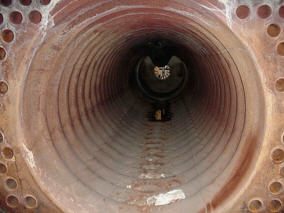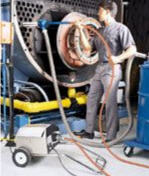Fireside Inspection
 Introduction
Introduction
There are two sides to every firetube boiler (and it’s NOT the inside and outside of the boiler). It is the Water Side and the Fire Side of the boiler. Both require inspection and the appropriate maintenance in order to keep the equipment running at peak efficiency.
Operation
A visual inspection of the fireside of the boiler should be conducted twice a year.
The fireside of the boiler includes all refractories, tubes, tube sheets and the furnace. Open the boiler up and use a strong light to visually inspect the condition of these surfaces.
- Look for blistering or pock marks. This is an indication that there is corrosion due to condensation of flue gasses. This condensation creates an acidic solution that can eat away at the furnace and tubes. Should this be occurring:
- increase the minimum water temperature to at least 170F
- avoid short-cycling the boiler, which can increase condensation and reduces efficiency
- consider improvements to the flue design to improve draft and prevent condensation from running back into the boiler
- consider adding a power-vent control system to the flue/chimney to better control draft see Exhaust Control
 Check the boiler tubes for soot deposits. Soot is a byproduct of combustion and can seriously reduce heat transfer. Poor heat transfer means poor efficiency. If there is soot present the boiler must be cleaned. If there is heavy sooting it is an indication of improper fuel-air adjustment. Depending on the fuel type, a properly adjusted boiler should only need to be cleaned once a year. Maybe more with fuel oil, less with natural gas.
Check the boiler tubes for soot deposits. Soot is a byproduct of combustion and can seriously reduce heat transfer. Poor heat transfer means poor efficiency. If there is soot present the boiler must be cleaned. If there is heavy sooting it is an indication of improper fuel-air adjustment. Depending on the fuel type, a properly adjusted boiler should only need to be cleaned once a year. Maybe more with fuel oil, less with natural gas.
Note: An indicator of dirty tubes is stack temperature. Install a stack thermometer. When the stack temperature rises above normal operating conditions, it is time to clean the tubes. (Or an indicator of another problem.)
- Check the tube sheet. Look for any evidence of leaking tube ends. They are indicated by a whitish deposit that streaks down from the tube end. Leaking tubes must be replaced.
- Be sure all gaskets and seals are in good condition. Air leaking into the boiler cause problems with combustion efficiency and can be a source of corrosion.
- Check the refractory. Make sure it is all tight and repair any substantial cracks. Use a wash coat to seal small cracks. If there are any loose bricks, repair or replace them. Be sure to follow recommendations for curing of repaired refractory.
